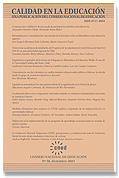Affirmative Actions for Women in STEM: A Comparative Analysis of Implementation in Chilean Universities
DOI:
https://doi.org/10.31619/caledu.n59.1382Keywords:
Affirmative Action Policies, Gender Equality, Women in STEM, Higher EducationAbstract
The persistent underrepresentation of women in Science, Technology, Engineering, and Mathematics (STEM) fields is a global concern, notably pronounced in Chile. This study investigates the recent adoption of affirmative actions, specifically preferential quotas, aimed at increasing female participation in these disciplines across four universities in the country. Our findings reveal that while the strategies and execution of these actions vary, they remain tethered to conventional admission protocols. Challenges arise in delineating eligibility criteria, underscoring the inherent tension between meritocratic principles and inclusive practices. While female students report higher levels of discomfort in terms of social and academic integration, they do not significantly differ from their male counterparts in academic performance, experiences of social marginalization, or encounters with discrimination. Notably, affirmative measures receive overwhelmingly positive evaluations from female and quota-admitted students. The latter group, in particular, places greater emphasis on gender as a salient factor in their university experience and identifies special admission as a potential source of discrimination, primarily from their male peers. This study recommends targeted efforts for awareness-building and dissemination of affirmative action policies, precise definition of entry requirements, and comprehensive strategies for the social and academic integration of students. These recommendations aim to foster an inclusive STEM environment that empowers women and promotes their equitable participation in these critical fields.
Downloads
Published
Issue
Section
License
Copyright (c) 2023 Calidad en la Educación

This work is licensed under a Creative Commons Attribution 4.0 International License.
Authors retain their Copyright and only transfer a part of these to the journal, accepting the following conditions:
Authors keep their rights as authors and guarantee the right to the journal for the first publication of their work, which is simultaneously subject to the Creative Commons Attribution license allowing third parties to share the study accrediting the author and first publication in this journal.
Authors may adopt other non-exclusive license agreements for distribution of the version of the published work (e.g. inclusion in an institutional thematic file or publication in a monographic volume) accrediting initial publication in this journal.
Authors are allowed and recommended to share their work over the Internet (e.g. in institutional telematic files or their website) before and during the submission process, which may lead to interesting exchanges and increased citation of the published work. (See The effect of open access).

